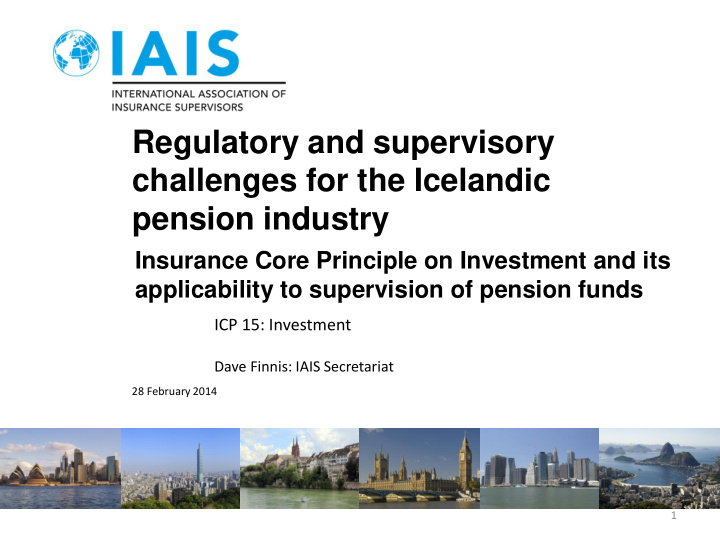



Regulatory and supervisory challenges for the Icelandic pension industry Insurance Core Principle on Investment and its applicability to supervision of pension funds ICP 15: Investment Dave Finnis: IAIS Secretariat 28 February 2014 1 1
Agenda • IAIS principle and standards Practical considerations • Examples of investment requirements Parallels with pension funding issues • Conclusions 2 2
ICP 15 Investment The supervisor establishes requirements for solvency purposes on the investment activities of insurers in order to address the risks faced by insurers. Insurers need to hold sufficient assets to cover technical provisions and regulatory capital requirements The solvency strength of an insurer depends in part on the quality and characteristics of assets held to meet these requirements There should be incentives for effective risk management Supervisors should be open and transparent on the requirements and be explicit about the objectives Comment: “Liability - Driven Investment” in its ultimate form? This means full funding in a form that reduces (minimises?) the chance of insolvency in future.. 3
Factors to Consider • Overall quality of risk management and governance • Valuation basis • Consistency with requirements on regulatory capital resources • Adequacy of disclosure requirements to foster market discipline • Size of net assets • Availability of assets locally and internationally 4
Minimum Regulatory Investment Requirements Security • Risk of counterparty default or that investment will lose value • Insurers must conduct own due diligence (CRA Ratings are helpfu , but only as an “extra string to the bow” • Particular attention to derivatives, use of special purpose entities and securities lending Liquidity • Ability to meet payments to policyholders and creditors as they fall due • Liquidity may be impaired if insurer pledges its assets, experience unexpectedly large claim, an event resulting in many claims Diversification • Diversification between risk categories – government bond vs. foreign property • Diversification within risk category – shares of different companies • Avoid concentration in terms of asset class, geographical location, sector, credit rating 5
Liability-driven Investments Nature: fixed, discretionary Liability Profile Duration Currency • Perfect matching is not expected (or possible in most instances) – but need to know extent of mismatch and address gap • For types of insurance business, even imperfect matching is not possible – ALM is needed (monitoring, transparency and measurement are key aims) • Close matching is usually expected for unit-linked policies 6
Risk Assessability • Insurers should: invest in assets for which risks can be identified, measured and managed be aware of the maximum possible loss in a transaction look through investment structures to understand the underlying assets 7
Complex and Less Transparent Assets Special • Although legally independent, there might be an implicit obligation of support from the insurer – reputational Purpose contagion risk • Consider prohibition of certain SPEs especially if used to Entities circumvent regulatory requirements. Structured • Could lose value due to increased correlation between asset classes in times of stress Credit • Consider quantitative and qualitative requirements to limit investments in such products Products • Examples: asset-backed securities, insurance linked securities • Could produce large liabilities from extreme low-probability market events Derivatives • Legitimate use for risk management purposes – hedging • Consider limiting use for speculative reasons or requirements on suitable counterparties 8
A recap of ICP 15 standards and their rationale • 15.1: The supervisor establishes requirements that are applicable to the investment activities of the insurer. • 15.2: The supervisor is open and transparent as to the regulatory investment requirements that apply and is explicit about the objectives of those requirements. • 15.3: The regulatory investment requirements address at a minimum, the Security; Liquidity; and Diversification; of an insurer’s portfolio of investments as a whole. • 15.4: The supervisor requires the insurer to invest in a manner that is appropriate to the nature of its liabilities. • 15.5: The supervisor requires the insurer to invest only in assets whose risks it can properly assess and manage. • 15.6: The supervisor establishes quantitative and qualitative requirements, where appropriate, on the use of more complex and less transparent classes of assets and investment in markets or instruments that are subject to less governance or regulation. 9
Types of Investment Requirements Rules-Based Principles-Based Prescriptive rules and restrictions, for example Set out high-level objectives and desired quantitative limits outcomes Prohibition of investments in certain assets Pros: more flexibility for insurer to choose investments that best meet their needs, less Pros: easy to enforce, limited scope for need to revise frequently different interpretations, readily explainable in court Cons: Might be difficult to take enforcement actions, open to different interpretations, Cons: stifles innovation and opportunities (e.g. more difficult to supervise in general foreign investments?), easy to arbitrage, discourages proper risk management, does not Example 1: Invest based on liability profile fit individual insurer’s specificities, Example 2: Invest to a desired probability of Example 1: <5% of total assets can be invested sufficiency of net asset base in any single counterparty Example 3: Manage through the use of an Example 2: Assets and liabilities must be authorised internal (actuarial?) model. matched by geography and type Example 3: Strict restrictions on derivative investments 10
Conclusions • At a minimum, investment requirements should address security, liquidity and diversification of assets • When considering ALM, the potential for matching, by type and term, should have a high priority • Insurers (and implicitly other bodies with similar “total balance sheets”) should invest in assets based on their liability profile and on their ability to understand and manage the underlying risks of those assets • More attention should be given to complex, less transparent assets 11
Thank you for your attention Contact details: Dave Finnis Telephone: + 41 61 280 8323 Mobile: + 41 76 350 8323 Email: Dave.Finnis@bis.org c/o Bank for International Settlements Centralbahnplatz 2 CH-4002 Basel Switzerland Website: www.iaisweb.org 12
Recommend
More recommend